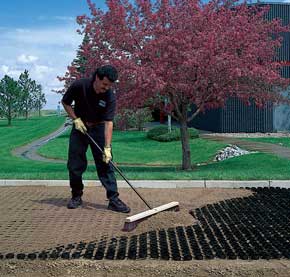Grasspave2
Why Sand in the Grasspave2 Root Zone?
“Turf geocells should be filled with sand.” – Ferguson, Bruce , Porous Pavements Continuing Education Program, University of Georgia School of Environmental Engineering, November 5th, 2004.
Sand root zones provide your grass, and grass porous paving system, the essential elements for 100% grass coverage. Organic soil root zones cannot match the drainage ability, the ability to supply oxygen, and the compressive strength and stability of sand. Invisible Structures, Inc. has been using sand in its Grasspave2 root zone since 1982, making our system the highest selling porous paving system in the world.**
*Based on United States Golf Association (USGA) recommendations. **Up to 2002 fiscal year.


Drainage
Sand drains extremely well under all weather conditions Soil drainage quality diminishes under varying weather conditions, consequently turf quality suffers.
Oxygen
Oxygen in the soil air must be maintained at levels 50 percent or greater than oxygen levels in the atmosphere, to prevent respiration deficiencies in the grass plant.
Porous sand root zones provide natural and extremely efficient oxygen supply.
Mechanical aerators cannot be used on porous paving systems – damage to the plastic may occur, jeopardizing the integrity of the system. Soil root zones in porous paving, cannot provide essential oxygen mechanically or naturally -sand must be used.
Prevention of high levels of carbon dioxide (CO2) in the root zone occurs naturally in sand. Maintaining low (proper) CO2 levels helps to ensure a quality plant.
Nutrients
Hydrogrow, a polymer-fertilizer mixture supplied with Grasspave2, provides nutrients to generate a healthy root system. The polymer can hold water for up to six months while the fertilizer supplies nutrients for optimal root and plant health.
Compressive Strength
Sand resists compaction, organic soils compact becoming deadly to grass root zones
Compacted soils expose porous paver plastic to damaging UV light, the plastic become brittle and vulnerable to vehicular damage.
Sand provides strength in the vertical and horizontal plane while providing drainage and aeration.
What Kind of Sand?
For our Grasspave2 porous paving, we prefer a clean sharp sand (washed concrete sand- AASHTO M6 or ASTM C-33) to fill the 25 mm (one inch) high rings and spaces between the rings. Major home centers and hardware stores have Quickcrete® All Purpose sand that meets our specification.
Links
HOW DO SOILS BREATH?
Like the air in the atmosphere, soil air is vital to turfgrass health. She-Kong Chong, Ph.D.; Richard Boniak; Chang-Ho Ok; Sam Indorante, Ph.D.; and F. Dan Dinelli, CGCS
ATHLETIC FIELD SYSTEMS STUDY
J.J. Henderson, J.R. Crum, J.N. Rogers, III, and T.F. Wolff. Departments of Crop and Soil Sciences and Engineering
Michigan State University
1998 RUTGERS UNIVERSITY TURFGRASS PROCEEDINGS
Dr. Ann B. Gould, Editor
Dr. Bruce B. Clark, Coordinator
COMPACTION RESISTANCE AND DRAINAGE:
The Driving Force Behind Sand Based Root Zones
By Eugene Mayer
ROOT ZONE SAND SURVEY
Principal investigator: Larry Stowell
